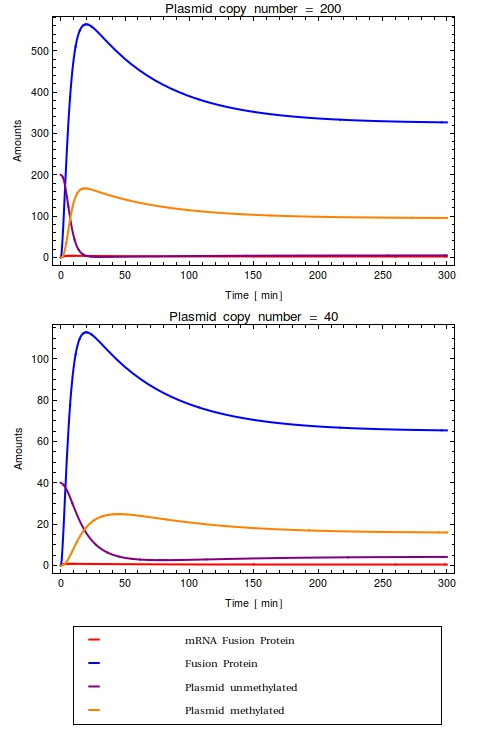Team:Amsterdam/achievements/stochastic model
From 2012.igem.org
(Difference between revisions)
(→Stochastic model definition) |
|||
| Line 16: | Line 16: | ||
<div class='clear'></div> | <div class='clear'></div> | ||
| + | |||
| + | ==Molecular design validation== Before starting the experiments, a lot of crucial parameters on the molecular system were still unknown. Both the leaky expression rate of the operon and the activity of the fusion protein were hard to model because of this. Sensible predictions on how the molecular system we were designing was going to function exactly therefore seemed impossible. We already expected the promoter/sensor we were going to test, pLac, to show some leaky expression. As to how much background activity this was going to cause, we couldn't predict and thus we proceeded to test out the construct in the lab. The [[Team:Amsterdam/Lab|laboratory results]] seemed to suffer from two problems: | ||
| + | * A basal methylation activity that was always recorded even in absence of the signal | ||
| + | This background noise reduces the dynamic range of our system; | ||
| + | there is no way to tell whether observed band intensities are due to the signal having passed the ''Cellular Logbook'' [[Team:Amsterdam/modelling/timeinferrance|some time ago]] or simply because of the background noise. | ||
| + | We conclude that storing a signal using the ''Cellular Logbook'' requires a transcriptional regulator that has a high repressing quality in order to diminish the background activity. | ||
| + | * A lack of a fully induced state for the pLac operon, but not for the later tested pBAD operon. | ||
| + | We suspect this problem to be caused by a low uptake rate of the signalling compound (lac operon inducer IPTG) compared to the amount of repressor LacI present in the system controlling the operons. | ||
| + | Especially for the part characterization experiments in which the pLac-MTase construct was cloned into a high copy number plasmid, this could be a problem. | ||
| + | This problem is solved by adding the ''LacY''-gene that codes for permease to the existing construct. | ||
| + | Inclusion of this gene might also lead to higher background methylation percentages in the negative controls, however. | ||
| + | |||
| + | == Stochastic Differential Equations == | ||
| + | Little amounts of certain key proteins can have large effects on the physiological behaviour of a cell. | ||
| + | When trying to accurately model these small amounts of proteins the thermodynamic equilibrium assumption that characterizes ODE-models might not be valid; | ||
| + | ordinary differnential equations are unsuited towards modelling systems with small integer amounts of the constituting species. | ||
| + | In these cases a finer-grained modelling method is called for: the Stochastic Simulation Algorithm by Gillespie. | ||
| + | By modelling each individual molecular reaction separately, the discreteness of this small amounts system is accounted for. | ||
| + | |||
| + | == Comparison of SSA implementations == | ||
| + | During the course of the summer we've investigated many stochastic simulation packages with implementation of the direct algorithms and some more coarse-grained optimizations thereof (e.g. the tau-leaping algorithm). | ||
| + | Most notable are xSSA for Mathematica and StochPy for Python. | ||
| + | The former is a great tool, but at the time of writing seems to lack the ability to process third order reactions (reactions with three reactants). | ||
| + | The latter has been developed at the Free University Amsterdam by Timo Maarleveld, currently PhD-student there. | ||
| + | In using this package, we've kept in close contact with Timo and submitted a lot of bug reports, helping the software to grow. | ||
| + | Additionally, we've also extended StochPy by writing a supplementary tool [[Team:Amsterdam/Software/MDL2LateX|MDL2LaTeX]], that eases the publishing of models developed with StochPy. | ||
== Leaky expression rate == | == Leaky expression rate == | ||
Revision as of 18:47, 26 September 2012
 "
"







